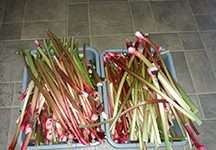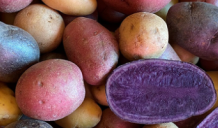1712 Claflin, 2021 Throckmorton Plant Science Center
Manhattan, KS 66506 (785) 532-6173
Download and print the Hort Newsletter
(Downloadable version)
HNR Website access: https://hnr.k-state.edu/extension/horticulture-resource-center/horticulture-newsletter/
ANNOUNCEMENTS:
The Kansas Forest Service’s Conservation Tree Planting Program offers tree and shrub seedlings, as well as other items for use in conservation plantings. Plantings may function as wildlife habitat, windbreaks, wood lots, timber plantations, or educational and riparian (streambank) plantings. Find out more and order trees by visiting: https://www.kansasforests.org/conservation_trees/
The 74th Annual Kansas Turf & Landscape Conference will be held on
December 4 & 5 (Wednesday & Thursday) at the Hilton Garden Inn,
Manhattan. The conference is an excellent way to learn about turf and
landscape management, visit with old friends, network with new ones, and see all the latest products and supplies from local and national vendors.
The conference has been approved for commercial pesticide recertification hours:
1 Core hour
3A – 7 hours
3B – 7hours
GCSAA education points and International Society of Arboriculture CEUS will also be available by attending the conference. For more information, visit:
https://www.kansasturfgrassfoundation.com/
VIDEO OF THE WEEK:
How to Plant a Tree
(Kansas Healthy Yards-KSRE)
If you’re planting trees this fall, use proper planting techniques to set them up for success.
GARDEN TO-DO
Divide perennials such as peonies and daylilies, if needed.
Prune broken and dead branches from trees.
Remove suckers and watersprouts from fruit trees.
ORNAMENTALS
What to Know About Bulbs
When fall rolls around flower gardeners are likely thinking about planting the usual bulbs, tulips and daffodils. There are many other bulb varieties that can be planted now for a spring show.
Hardy bulbs are the varieties that require a chilling period. For home gardeners this typically means planting in the fall for the delayed gratification of spring blooms.
Here are some hardy bulbs to consider if you want to add more variety to your spring show:
Hyacinth
Allium
Asiatic Lily
Crocus
Snowdrops
Oriental Lily
Time to Plant Spring-flowering Bulbs Approaching
Spring-flowering bulbs can be planted from now through October giving them time to establish roots before winter.
Choose an area with full sun to part shade. Ideally the soil should be sandy loam, but if not, amend it by adding compost to a depth of at least one-foot. Good drainage is essential. Incorporate fertilizer only if recommended based on a soil test. The soil pH should be between 6.0 and 7.0.
Determine the planting depth based on the bulb size. Bulbs the size of tulips and hyacinths are typically planted six-inches deep while daffodil-size bulbs should be six- to eight-inches deep. In general, bulbs should be planted two to three times as deep as their width. This is determined by the distance from the depth the base of the bulb will rest to the soil surface after the hole is backfilled.
Space large bulbs four- to six-inches apart. Small bulbs can be spaced one- to two-inches apart. Mass plantings create a more aesthetically-pleasing display when spring blooms emerge.
Backfill each hole halfway and water in to settle the soil. Replace the remaining soil and water again. Though you will not see above-ground growth in the fall, roots are still growing. Keep the soil moist and add mulch after the soil freezes to provide insulation and prevent bulbs from being heaved out of the soil.
MISCELLANEOUS
Henbit Control
Though more noticeable in the spring, fall is primarily when henbit is germinating.
Henbit is most easily identified by the purple blooms in spring. When large clusters flower they can actually be quite lovely. Henbit serves as an early season nectar source for honeybees.
In lawns, henbit can be prevented by maintaining healthy, dense turfgrass. This includes mowing at the proper height, fertilizing according to recommendations and choosing the right grass variety for the growing conditions.
Preemergence can be used in mid-September and post-emergence can be applied in October for henbit control, if desired. See KSRE publication Henbit and Chickweed for more information.
Planting Trees in the Fall
Fall can be a great time to plant trees so roots can establish before freezing temps arrive. This timing better prepares trees to endure the stress of spring growth and summer heat/drought. Early September to late October is the ideal planting time for most trees. Some exceptions include: beech, birch, redbud, magnolia, tulip poplar, willow oak, scarlet oak, black oak, willows and dogwood. These trees will not be able to establish roots in time to survive the winter.
Newly planted trees require some care even when the above-ground growth is dormant. Keep the soil moist so roots do not dry out. Apply a layer of mulch to regulate the soil temperature and reduce water loss.
Moving Houseplants Inside for the Winter
If you moved houseplants outside last spring, it’s time to start watching the weather and acclimate them to the indoors again.
Before bringing any plants indoors, check for pests. Small populations of insects, such as mites and aphids, can be dislodged by spraying the foliage with a hose. If insects are found in the soil, soak the entire container in lukewarm water for 15 minutes.
Once indoors, continue to monitor for pests to prevent their spread throughout the house. Plants will grow much slower indoors and require less water. Most houseplants will benefit from receiving water only when the soil surface is dry. They will likely not need to be fertilized until spring.
Help plants adjust to the lower light conditions indoors gradually to prevent leaf drop. Initially, place plants indoors near windows that allow in the brightest light. Over several weeks move the plants further away until they’re in the desired location. There are many styles of grow lights that can be used to provide supplemental lighting, if needed. Avoid cold drafts from doors and windows and heat from air vents. These extremes can put plants under stress.
Many houseplants come from tropical locations and favor humid conditions. Kitchens and bathrooms tend to be humid areas inside the home and may be good locations for your plants if space and lighting permits. You can increase humidity by using a humidifier or grouping multiple plants together to create a microclimate.
QUESTION of the WEEK
Weed ID
This plant comes up in my landscape in the fall and quicky spreads. Should I leave it as a groundcover or remove it?
This looks like Glechoma hederacea, commonly known as ground ivy or creeping Charlie. It is a member of the mint family and spreads aggressively. It is acclimated to a variety of growing environments but favors shaded sites with poorly drained, fertile soil.
For small patches, removing by hand can be effective if repeated as needed. To prevent it from establishing in a lawn, maintain healthy, dense turfgrass. In planters, improve drainage by incorporating organic matter, water less frequently and reduce the shade by pruning trees to help control creeping Charlie.
Broadleaf herbicides can be used, but can also cause harm to landscape plants. The decision of whether or not to remove the plants is yours, but know that it will continue to spread if not maintained.
Read more: KSRE publication Ground Ivy (Glechoma hederaceae)
Contributors:
Cynthia Domenghini, Instructor and Horticulture Extension Specialist
Division of Horticulture
1712 Claflin, 2021 Throckmorton
Manhattan, KS 66506
(785) 532-6173
For questions or further information, contact your local extension agency.
This newsletter is also available on the World Wide Web at:
http://hnr.k-state.edu/extension/info-center/newsletters/index.html
The web version includes color images that illustrate subjects discussed. To subscribe to this newsletter electronically, send an e-mail message to [email protected] or [email protected] listing your e-mail address in the message.
Brand names appearing in this newsletter are for product identification purposes only. No endorsement is intended, nor is criticism implied of similar products not mentioned.
K-State Research and Extension is committed to making its services, activities and programs accessible to all participants. If you have special requirements due to a physical, vision or hearing disability, or a dietary restriction please contact Extension Horticulture at (785) 532-6173.
Cynthia Domenghini, Ph.D.
Instructor; Horticulture Extension Specialist
Department of Horticulture and Natural Resources
Kansas State University
1712 Claflin Rd.
Manhattan, KS 66503
785-340-3013
[email protected]
Access the HORTNEWS-L Home Page and Archives
Unsubscribe from the HORTNEWS-L List





